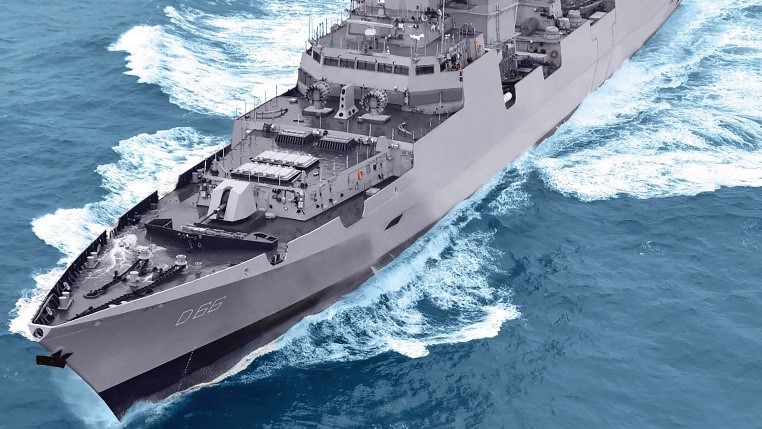INS VISHAKHAPATNAM

Disclaimer: Copyright infringement not intended.
Context
- To enhance the maritime partnership between Indian Navy and Royal Oman Navy, the indigenously built destroyer INS Visakhapatnam entered Oman.
Destroyer
- In naval terminology, a destroyer is a fast, manoeuvrable, long-endurance warship intended to escort larger vessels in a fleet, convoy or battle group and defend them against smaller powerful short-range attackers.
- A total of 16 such vessels have served, or are currently serving, in the Indian Navy.
- Currently, the Indian Navy operates 10 guided missile destroyers from three different classes namely the Kolkata class, Delhi class, and Rajput class.
- In addition, six other destroyers have been decommissioned: three were from the R-class and three were from the Hunt class. All the decommissioned ships were scrapped.
- INS Kolkata, the lead-ship of Kolkata-class destroyers with about 7,500 tonnes of displacement, is largest destroyer presently in service with the Indian Navy.
- An extensively improved version of the Kolkata class, INS Visakhapatnam, part of the Visakhapatnam class, was launched in April 2015.
INS Visakhapatnam
- INS Visakhapatnam is the lead ship and the first of the Visakhapatnam-class stealth guided-missile destroyers of the Indian Navy. It was commissioned on November 21, 2021.
A guided-missile destroyer (DDG) is a destroyer whose primary armament is guided missiles so they can provide anti-aircraft warfare screening for the fleet.
- INS Visakhapatnam measures 163m in length, and 17m in breadth with a displacement of 7,400 tonnes, and can rightfully be regarded as one of the most potent warships to have been constructed in India.
- The ship is propelled by four powerful Gas Turbines capable of achieving speeds in excess of 30 knots.
- The ship has enhanced stealth features resulting in a reduced Radar Cross Section (RCS) achieved through efficient shaping of the hull, full beam superstructure design, plated masts, and use of radar transparent materials on exposed decks.
|
RADAR CROSS-SECTION (RCS) Radar cross-section (RCS), denoted σ, also called radar signature, is a measure of how detectable an object is by radar. A larger RCS indicates that an object is more easily detected. |
- The design of the ship is almost 65 percent indigenous, which is significantly higher compared to its predecessors.
- This ship will have a full-fledged Total Atmosphere Control System (TAC) for the ship’s air conditioning and ventilation system.
- It is equipped with 8 Brahmos missiles and has Ukrainian-built Zorya gas turbines.
- It is outfitted with the Israeli Multi-Function Surveillance Threat Alert Radar (MF-STAR).
- This is one of the few warships in the world to have a Multi-Function Surveillance Threat Alert Radar to provide data to Long Range Surface to Air Missile system.
- The ship is equipped with Ship Data Network (SDN), Automatic Power Management System (APMS) and Combat Management System (CMS) and is termed as ‘Network of Networks’.
- The ship symbolises India's matured shipbuilding capability and the quest for the 'Make-in-India' initiative towards achieving 'Atmanirbhar Bharat'.
- The crew of the ship abides by her motto 'Yasho Labhasva', a Sanskrit phrase that translates to 'Attain Glory'.
Visakhapatnam-Class Destroyers
- The Visakhapatnam-class destroyers, also classified as the P-15 Bravo class, or simply P-15B, is a class of guided-missile destroyers currently being built for the Indian Navy (IN).
- The destroyers were designed by the Indian Navy's in-house organization, the Directorate of Naval Design.
Features
- The destroyers are equipped with a "Total Atmosphere Control System" (TAC), which allows them to operate in regions of nuclear fallout.
- Additionally, the destroyers are also equipped with nuclear, biological and chemical warfare (NBC) protective equipment, with its entire requirement of air being filtered through NBC filters.
- An estimated 72% of the destroyers' components are indigenously sourced, as compared to 59% for the Kolkata-class destroyers and 42% for the Delhi-class destroyers.
- The destroyers feature multiple fire zones, battle damage control systems and distributional power systems for improved survivability and reliability in emergent conditions.
- The destroyers feature ergonomically-designed accommodations based on modular concepts, which ensures a significant amount of crew comfort.
India and Oman Strategic Partnership
- The Indian Navy and Royal Oman Navy are working together to address security challenges in the region and the warship is part of the Western Naval Command Fleet.
- The Sultanate of Oman is a strategic partner of India and an important interlocutor at Gulf Cooperation Council (GCC), Arab League and Indian Ocean Rim Association (IORA) fora.
- India and Oman are linked by Geography, History, and Culture and enjoy warm and cordial relations.
- While people-to-people contact between India and Oman can be traced back 5000 years, diplomatic relations were established in 1955 and the relationship was upgraded to a Strategic Partnership in 2008.
|
PRACTICE QUESTION Q. Consider the following statements with reference to P-15 Bravo class of Guided-Missile Destroyers: 1. The P-15 Bravo class of guided-missile destroyers are equipped with a "Total Atmosphere Control System" (TAC). 2. The destroyers are equipped with nuclear, biological and chemical warfare (NBC) protective equipment. 3. 100% of the destroyers' components are indigenously sourced. How many of the above statements are incorrect? (a) Only one (b) Only two (c) All three (d) None Correct Answer: (a) Only one Statements 1 and 2 are correct. |



.jpg)

1.png)
